Yesterday was technically Lake George cleanup day, so here is the stuff I found.
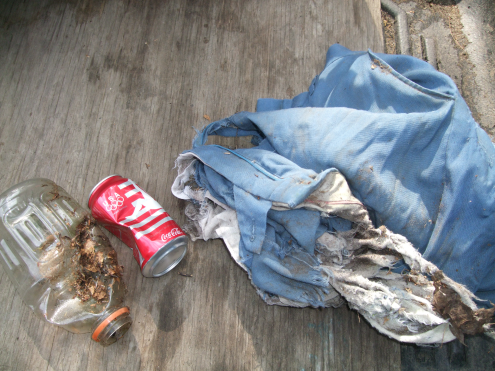
Junk I found in the bed of a stream that flows into Lake George.

Debris I found along the shoreline on the lake.

News & Opinion About Huletts Landing, N.Y.
Yesterday was technically Lake George cleanup day, so here is the stuff I found.

Junk I found in the bed of a stream that flows into Lake George.

Debris I found along the shoreline on the lake.
In partnership with The Nature Conservancy (TNC), the state has acquired 156 acres on Southern Lake Champlain in the Town of Dresden, Washington County that will be added to the State Forest Preserve, NYS Department of Environmental Conservation (DEC) Commissioner Joe Martens announced on Tuesday, July 31st.
Known as the Chubbs Dock property, the land features 2,140 feet of undeveloped shoreline on Lake Champlain and 70 acres of wetlands that support rare plants and falls within an area that provides critical breeding, staging and migration habitat for thousands of waterfowl species.
“Chubbs Dock conserves excellent wildlife habitat along the narrow headwaters of Lake Champlain,” said Commissioner Martens. “The property will be added to the Forest Preserve and serve as part of a travel corridor for wildlife between the Adirondack and Green Mountains. Thanks to our partners TNC, Washington County and the U.S. Fish and Wildlife Service for making this land preservation possible.”
With funding through the U.S. Fish and Wildlife Service’s North American Wetland Conservation Act grant program, TNC purchased the property for $500,000 in November 2009. The property was then donated to New York State in May 2012. TNC has previously utilized North American Wetlands Conservation Act (NAWCA) grants to protect Mill Bay Marsh and Huckleberry Marsh in the Lake Champlain watershed.
“This is a great example of strategic, high leverage conservation work of regional and national importance,” said Michael Carr, Executive Director of the Conservancy’s Adirondack Chapter.
“Not only is New York State keeping intact some of the largest wetlands on Lake Champlain, but doing it in a way that will also secure public access for hunting, fishing, boating, and wildlife-oriented recreation-all of which contribute to the state’s outdoor recreation economy.”
The NAWCA grant application was supported by Washington County and included a commitment by the county to transfer an adjoining 283-acre tract on Maple Bend Island. Both transfers happened this year, adding a total of 439 acres with significant wetlands to public ownership. As part of the Forest Preserve, DEC will pay taxes on both properties. Public access to Lake Champlain and its shoreline is limited because most of the shoreline is privately owned. State acquisition of Chubb’s Dock will provide for new public access.
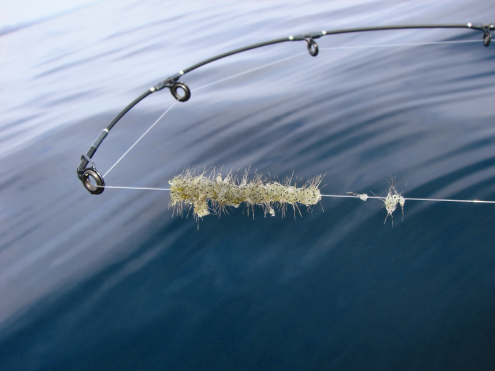
This picture, courtesy of Jeff Gunderson of Minnesota Sea Grant, shows a clump of spiny waterfleas on a fishing line.
Spiny water flea (Bythotrephes longimanus), an aquatic invasive zooplankton native to Eurasia, has been found in Lake George.
The spiny water flea is very small (about ½-inch long). It is not an insect, but is actually a cladoceran, a type of crustacean. While not technically microscopic, it is still very small with about 70% of the length being a thin barbed tail. Many spiny water fleas look like bristly masses of jelly with black eye spots when tangled on fishing lines, reels and other equipment. This species has had negative impacts on Rainbow Smelt and other small fish which are a large forage base for many game fish species. Impacts on fisheries and other aquatic life in the Lake is of concern as this species reproduces rapidly, altering the structure of the in-lake food web. It is of no danger to humans or domestic animals. There is no known current management for spiny water flea. Once it is in a body of water, it is there.
“The most frustrating aspect of this discovery is that we have no recourse that we are aware of now that it is here. You can’t eradicate or even try to manage spiny water flea in a water body as vast as Lake George,” said Walt Lender, the LGA’s executive director.
An angler on his way out of Lake George on Friday, July 27 showed the LGA Lake Steward on duty at the Mossy Point Boat Launch in Ticonderoga a mass of material that had collected on his line when fishing. The Lake Steward collected the sample, and the sample was transported to Larry Eichler at the Darrin Fresh Water Institute in Bolton Landing to confirm the identification. It was confirmed as spiny water flea. On Tuesday, July 31, staff from the Lake George Association used plankton nets to sample in the area where the angler had been fishing; additional spiny water fleas were found in the northern basin just west of Mallory Island. These samples were also confirmed as spiny water flea by Larry Eichler at the Darrin Fresh Water Institute.
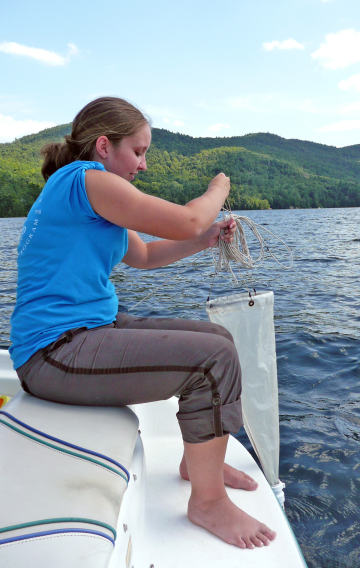
To further confirm that an angler had indeed found Spiny water flea in Lake George, the LGA needed to get out on the Lake fast for some additional sampling in the area. LGA members Ken and Jane Robbins, who live in Gull Bay, came to the rescue and took out Kristen Rohne, LGA watershed educator, pictured here.
“It is still too soon to know how widespread the infestation is,” said Emily DeBolt, director of education for the LGA and coordinator of the LGA’s Lake Steward Program. “We went out yesterday to sample to confirm its presence, but we don’t know much more than that it is here. We are working with the Lake George Park Commission, Darrin Fresh Water Institute, and our partners to coordinate additional sampling so that we have more information.”
“Right now the Commission’s top priority is invasive species control and management, and we will work with our many partners on determining the extent of this population,” said Dave Wick, executive director of the Lake George Park Commission. “The Commission is currently developing a comprehensive invasive species prevention plan for Lake George, with the goal of preventing any new invasive occurrences from entering the lake,” he added.
Spiny water flea infested the Great Lakes in the 1980s, but wasn’t found in inland waters of the state until 2008 when it was confirmed in nearby Great Sacandaga Lake. From there it has spread, being confirmed in Peck Lake in 2009, the Stewarts Bridge Reservoir, and Sacandaga Lake in 2010, and the Glens Falls Feeder Canal and Lake Champlain Canal just a few weeks ago in July 2012.
“While this is most definitely not good news, I guess the silver lining is that it is an example of how important education is and that it can work,” said Emily DeBolt. “Some days we feel like a broken record with our spread prevention messages – but this instance shows us that people are listening. It’s encouraging that our messages have reached the population in such a way that an angler recognized that he had something bad on his line and brought it to the attention of one of our Lake Stewards.”
“This is a very disturbing development,” said Lender. “It shows us that we must do more to stop the spread of invasive species. We have no way of telling how spiny water flea came into Lake George and there is little we can do now that it is here, but we should not lessen our efforts to keep invasives out. There are too many on the horizon: species that can do much more to harm our water quality than spiny water flea. This will have a negative effect on our fish population over time, but it will not do the same damage as some of the aquatic plants that have been discovered in other New York lakes such as hydrilla or some of the other animals like quagga mussels or Asian carp.”
This is a great event and a wonderful reminder to always try to pickup loose trash. Because if it isn’t picked up, it ends up in the Lake.
I’m going to take part myself and I’m going to post a picture of the stuff I find.
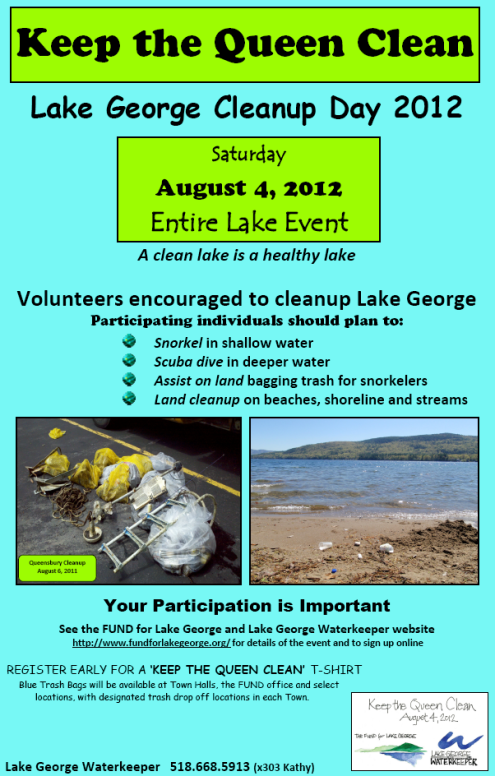
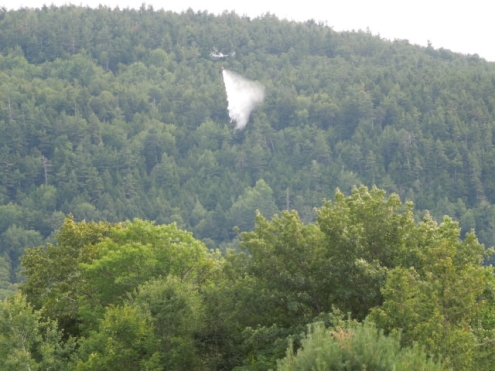
Yesterday’s fire on Elephant mountain is described firsthand by Huletts fireman, Pat Paterson, who was at the fire site.
Today, I had a chance to talk with Huletts Landing Fire Chief, Jay Vanderplatt, and fireman, Pat Peterson, about yesterday’s fire on Elephant mountain. Pat Peterson brought two NY state forest rangers to the scene of yesterday’s fire and was actually on the ground when the water was dropped.
At about 11:30 a.m. on Thursday, July 25th someone reported seeing whiffs of smoke on Elephant mountain. When the Huletts volunteers got the call, Pat, accompanied by Huletts Landing Fire Chief, Jay Vanderplatt, and a few other Huletts Landing firemen went out on Lake George by boat to get a clearer view. Once the site was established, forest rangers were called and the site was designated on a map.
Sometime in the early afternoon, Pat and one forest ranger headed up the Elephant mountain trail on an ATV with supplies. They could only drive about halfway to the fire site because downed trees blocked the path. Because of this, they had to climb the rest of the way. Another forest ranger followed about 45 minutes behind them.
Pat Peterson did confirm that the fire appeared to have been started by a lightening strike two days earlier and was smoldering in the ground for some time. When they saw the fire for the first time it was long and narrow and was going up the mountain. Pat’s estimate was that it was roughly 100 feet long and about 10 feet wide. The original tree where the lightening hit had a strike mark on it according to Pat. “You could see the hit mark and the lightening must have traveled through the root and ignited some pine needles. It was difficult terrain, because it ran up the mountain,” said Pat. “We had to crawl on our hands and knees, it was so steep.”
Once they saw the fire, the forest ranger contacted NY state officials and a decision was made to bring in the state police helicopter. A perimeter was established by Pat and the two forest rangers and before each water drop they scampered above the fire to get a clearer view of the water hitting the target. “We couldn’t see the helicopter until it was right over us,” said Pat, who would call in a “3, 2, 1.. drop” to the helicopter above him. “The pilot did a heck of a job. Every time we called for water on a certain spot, she put it right on the mark.”
Pat continued, “Seeing that water come through the trees was such a sight. But it’s dangerous also, the water has a lot of weight and can knock off heavy limbs that can really hurt you. Every time the chopper came in, we had to climb above the site and after it left we had to climb down and see what was left of the fire.”
After a number of water drops the fire came under control. Pat was emphatic about yesterday’s events. “It was really touch and go at the beginning. If that fire had ignited some trees, the entire mountain could have gone up.”
Many thanks to Pat Paterson, the entire Huletts Landing Volunteer fire department, the NY state forest rangers, the state police and all those who responded yesterday.
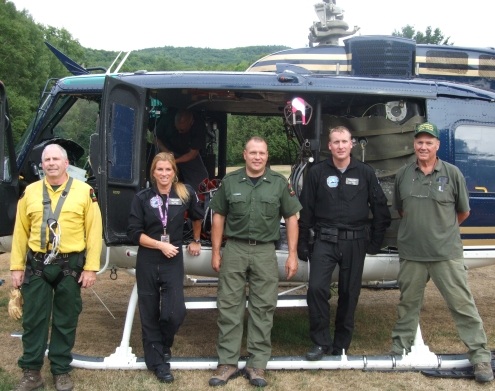
Bill Ingleston, Assistant Dresden Fire Chief (far right), stands with the crew of the helicopter that extinguished the Elephant Mountain fire after they landed on the Huletts Landing Golf Course. State police pilots are in blue. Forest rangers are in yellow (left) and green (middle). (Click on picture to see full-scale. This picture only.)
6:34 PM
The helicopter has departed Huletts Landing and there is no visible smoke coming from Elephant Mountain. It appears that the fire has been extinguished.
5:57 PM
The helicopter has stopped making water drops after two rangers on the mountain called them off. (The fire appears extinguished.) The helicopter is now on the golf course unloading.
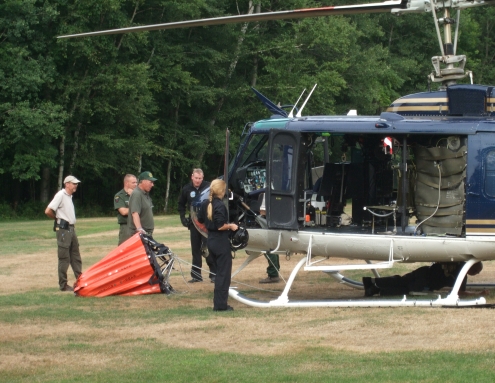
The orange water bucket is in front of the helicopter.
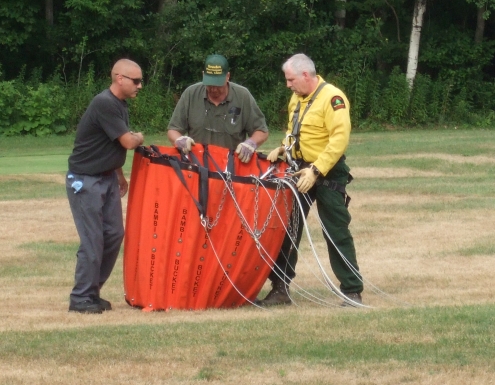
The bucket that dropped thousands of gallons of water on the fire.
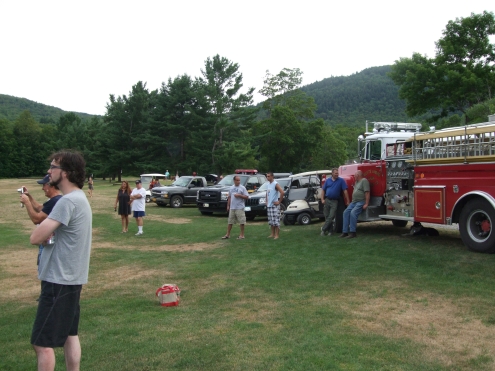
Spectators and volunteer firemen wait and watch.
5:37 PM
Water drops are continuing with the state helicopter going in for pass after pass. First reports are that the fire was first seen around noon, rangers needed to be called in, who called in state police helicopter who got permission from the Lake George Park Commission to remove water from lake.
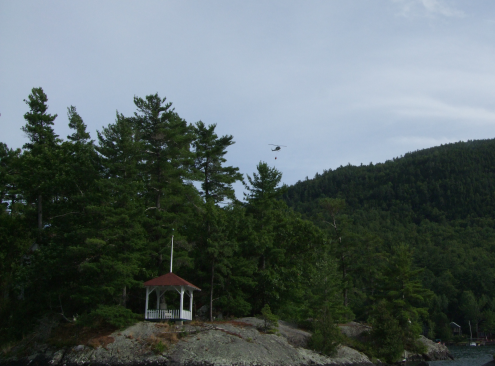
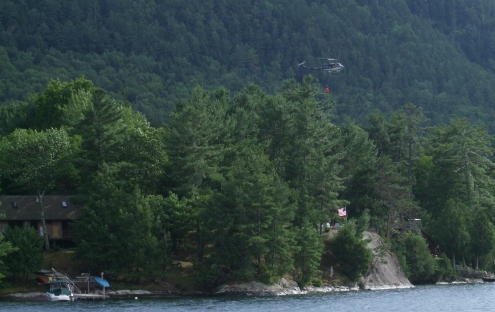
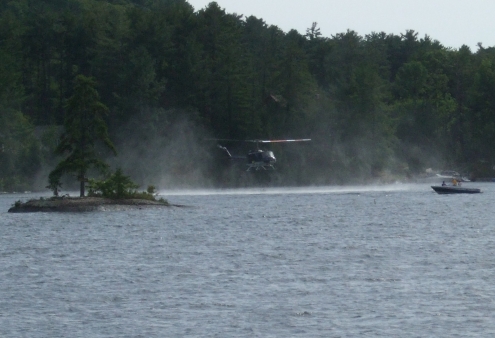
5:29 PM
After numerous water drops (at least 15) the smoke appears to be lessening.
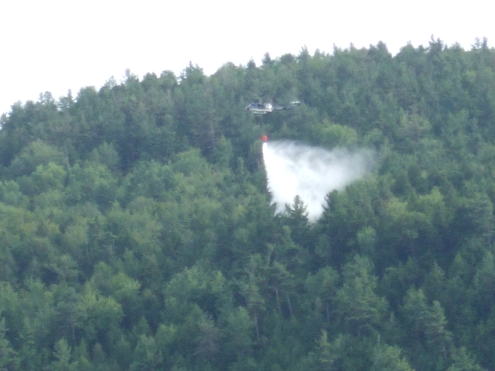
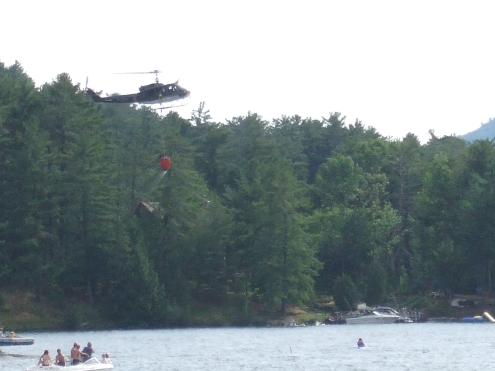
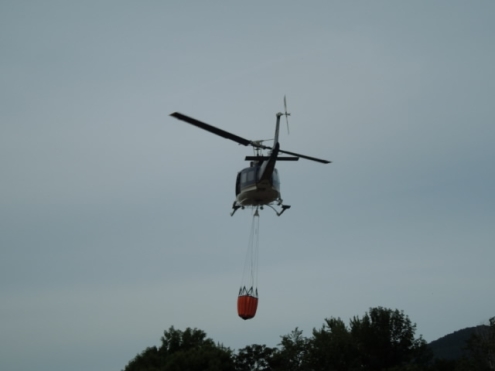
5:17 P.M BREAKING
A fire on Elephant Mountain has brought in state forest rangers and a state police helicopter with a bucket in an attempt to douse the blaze. Numerous water drops have already occurred.
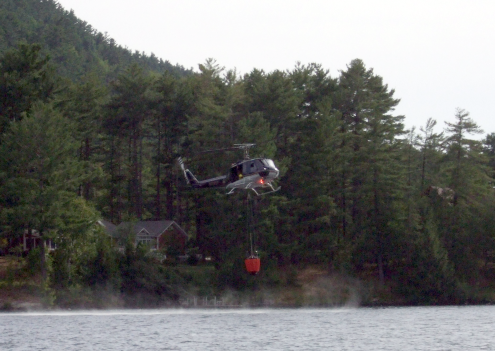
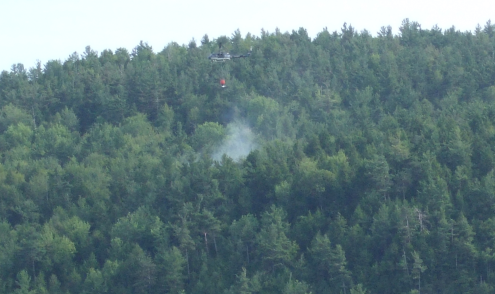
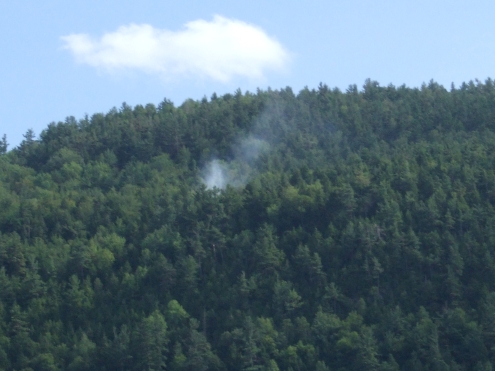
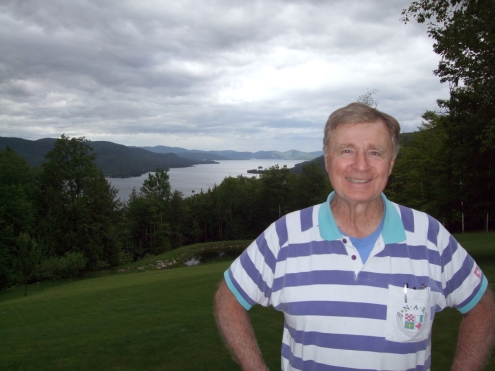
Huletts Landing resident, Bruce Young, was recently appointed to a third term as Chairman of the Lake George Park Commission by Governor Cuomo.
During the last day of this terms legislative session, Bruce Young, a life-long Huletts Landing resident, was confirmed by the New York State Senate to a third term as Chairman of the Lake George Park Commission (LGPC). Mr. Young was originally appointed by Governor Pataki in 1996 and reappointed to a second term in 2002. “I have served under four different Governors and am pleased to have been appointed by Governors from both parties”, said Young.
Asked to reflect on his tenure at the helm of the LGPC, Mr. Young stated, “I think that the important things to reflect on are the successes of the Commission. Our lake safety patrol has been repeatedly honored for its outstanding safety achievements, many of which have been life saving. Our stormwater regulations have been nationally recognized and are used as a model program by other states. We are also winning the battle with eurasion millfoil having eradicated over 150 of the discovered sites. My fellow commissioners and our permanent staff have worked diligently to protect the treasure that is Lake George.”
When discussing his hopes for the future, Mr. Young stated, “We’ve got to control invasive species. We have to come up with a plan that will not only combat the major threats that we face today such as asian clams and zebra mussles, but also those that are sure to come down the pike in the future. We live in the age of an extremely mobile society where you can literally be wading in an asian rice paddy one day and swimming in Lake George the next. We also need some sort of reasonable stream corrider protection plan.”
Young, who grew up in Huletts Landing, spent his summers caddying at the golf course (yes, there was a day when people used caddies) and later working at the front desk of the Huletts Hotel. “I have fond memories of carrying two bags every Saturday for Mr. Nash and Mr. Eichler and would receive the grand total of $5.00 a day, a huge sum for a teenager in 1950 when a good salary for a skilled worker was $1.00 per hour. The many guests I met working at the front desk was a valuable introduction into the world outside Huletts Landing”, said Mr. Young.
After graduating from Cornell University, Mr. Young entered the United States Air Force where he finished first in his pilot traing class. Given his first choice of assignments he quickly selected his life long ambition of fighters. He was then selected to attend the Air Force’s Advanced Interceptor Fighter School, the Air Force’s version of “top gun.” Graduating at the top of his class there, he won the Air Force’s equivalent of the “Top Gun” award made famous by the movie of the same name featuring Tom Cruise. He spent his active duty years flying the Air Force’s top fighter, the Mach 2 F-106, participating in the Cuban missile crisis and other “Cold War” missions that are still classified.
After active duty, Mr. Young was a pilot for United Airlines for 30 years, finishing his career as a Boeing 747 Captain. He is married to Susan Young, a local realtor, has two daughters and four grandchildren.
Young is also an avid collector of Huletts Landing memorabilia. He demonstrated for me the telegraph morse code transmitter from the old steamship office at the big boat dock. He also possesses an old Huletts ice saw. “My grandfather used that saw to cut ice from the lake for the hotel in the 1920s and 30s.”, said Young. He also has a framed photo of his grandparents, mother and aunts and uncles at the laying of the cornerstone of the Mountain Grove Memorial Church in July 1922. Mr. Young’s grandfather, Harland Foote, was the builder of the stone church.
“Since I retired, I’ve dedicated my life to three things”, continued Young. “First is my love for Lake George and my work with the Lake George Park Commission. Additionally I’m also involved with the Mountain Grove Memorial Church where I’ve been a Trustee and Treasurer since 1990. Last, but not least, I’ve served as the Trustee of a Cornell University scholarship fund for 35 years. Years ago I remarked to fraternity brother, Ezra Cornell IV, that sholarships should be based on scholastic performance and have been stuck with the job ever since.”
“When I look out at this beautiful body of water I realize that my job is to protect it, but while doing so, to always remember that our citizens are part of the Lake George story and that their legitimate rights need equal protection. It may be a quaint phrase, but I believe in maximum use without abuse. I believe that being appointed to three consecutive terms by different governors is evidence that the approach we’re taking is the right one”, said Young.

Lake George Village Mayor Robert Blais presented a framed copy of the bookmark to winner, Lynnaya Preuss, at the Lake George Central School.
The Lake George Association has announced the winner of the fifth annual Lake George Bookmark Design Contest, sponsored by the LGA and the village of Lake George. The winning design, created by Lynnaya Preuss, a 5th grade student at Lake GeorgeElementary School, features a young boy and girl looking out on the Lake with the slogan: ‘‘We are the future. Make the right choices. Keep our lake clean.’’
The bookmarks are available for free distribution through libraries, schools and other public venues. ‘‘If your organization would like to distribute the bookmarks, please contact us,’’ said LGA Director of Education Emily DeBolt.
In presenting the award, Mayor Blais asked the students ‘‘How many of you wish you could be swimming in the Lake right now?’’ Dozens of hands immediately shot up. He reminded the students that Lake George is not only the source we rely on for swimming and recreational fun, but for the very water we drink.

Lynnaya’s winning entry.
Each spring students are asked to focus on lake and watershed issues, such as water quality, invasive species, aquatic and terrestrial plants and animals, streams and wetlands, pollution, lake ecology and lake health. Through designing their own bookmarks, students try to encourage people to protect Lake George as an important natural resource.
The contest is open to students in Grades 4-7 from schools located within the Lake George watershed. Eight different area schools participated
this year: Bolton, Queensbury, Putnam, Lake George, Whitehall, Fort Ann, Ticonderoga, and St. Mary’s.
‘‘We received scores of entries this year, more than we ever have. Every year it is so much fun to look at all the entries we get,’’ said Ms. DeBolt. ‘‘There are always so many good ones that it is never an easy decision to pick just one winner.’’
Today, I post an interview I did recently with Richard Hayes Phillips, who in addition to owning a cottage in Dresden, wears many hats. Mr. Phillips sits on the Conservation Committee of the Lake George Land Conservancy, has testified in some high-profile environmental cases across the country, and also actually knew John Apperson, the famous preservationist who single-handedly preserved some of Lake George’s most pristine shoreline, including Dome Island. Richard has mapped and blazed many trails around Lake George and recently the Lake George Land Conservancy named the trail between Cat and Thomas mountains after him.
Richard, to begin, how did you find out about the Lake George Land Conservancy?
My father had a summer place on Pilot Knob Road. As a young boy I used to wander the old logging roads to the meadow, and bushwhack up the cliffs to the Pilot Knob ridge. One day when I went to visit my father I saw the Lake George Land Conservancy trail head directly across the road, right where I used to walk. They had a map displaying all of their land purchases, including Spruce Mountain in the Town of Dresden and Cat Mountain in the Town of Bolton. I was so moved by their accomplishments that I conducted a two-county search for an affordable piece of land that could provide public access to one of these newly acquired parcels. And that is how I came to own my little red schoolhouse, and twenty-three acres, on North Road in Dresden.
Can you tell us about your work for the Lake George Land Conservancy?
I called them up and asked: “Would you like to have a trail along the Cat Mountain Range? I used to trespass there all the time as a boy. I know it by heart.” That was all it took. I spent forty-two days scouting, cutting, and marking a foot trail from the kiosk at Valley Woods Road to the summit of Cat Mountain, via Thomas Mountain and three lesser summits, and thence to Edgecomb Pond. The trail to the summit of Thomas has been rerouted twice, but the Richard Hayes Phillips Trail from the Thomas cabin to Cat Mountain is the original route, exactly as I cut it, with hand tools, in 2005.
How would a person get to the trail, named in your honor?
From the crest of County Route 11, between Northway Exit 24 and Bolton Landing, take Valley Woods Road south and you will see the parking lot and kiosk on your right. A gravel road, with orange trail markers, leads toward Thomas and Cat. In less than a mile there is a gravel pit and reforestation area on the right, with a small stream just beyond it. On the far side of the stream, to the right, you will see the foot trail, with blue trail markers, leading to the summit of Thomas and to the cabin. Or you can take the orange trail, the gravel road, to the cabin. The Richard Hayes Phillips trail, with blue trail markers, officially begins there, descending the Thomas ledges and wending its way through the wild forest to the summit of Cat Mountain. Some of the rock cairns along the route I built almost forty years ago. Descending from the summit of Cat are two more of my trails — the red trail to Edgecomb Pond, and the white trail toward Trout Lake. These will not take you back to the parking lot.
The Lake George Land Conservancy is establishing some wildlife refuges around the lake. Can you tell the readers of the Huletts Current something about all of these?
The Lake George Land Conservancy was instrumental in the purchase of 900 acres in the Town of Dresden, including 2.6 miles of shoreline, all of which is now state land and part of the of the Adirondack Forest Preserve. In the Town of Putnam, the Conservancy still owns 1000 acres with 5900 feet of shoreline. These lands, known as the Gull Bay Preserve, the Last Great Shoreline, and Anthony’s Nose, are now designated as wildlife refuges, the first in the Lake George watershed. The Gull Bay Preserve contains a great blue heron rookery. The Last Great Shoreline includes Jumping Rock and some spectacular back country. Anthony’s Nose has 300-foot ledges that are nesting areas for raptors.
Are any of the refuges open to the public?
All are open to the public, but not all have public parking, and not all have marked trails. We are working on this. The Gull Bay Preserve is accessible from Sagamore Road (north of Gull Bay Road), and the Last Great Shoreline Preserve is accessible from Warrick Road (south of County Route 1, or Glenburnie Road). We do ask that hikers stay on the marked trails, which are designed to avoid dangerous terrain and to protect sensitive wildlife habitat.
If people want to assist with your work with the Lake George Land Conservancy, can they help?
The Conservancy is always looking for volunteers. And I have been known to hire trail workers out of pocket, thus proving that not all job creators are wealthy. It is hard work, and it doesn’t pay real well, but you can’t beat the workplace. Not many people get to watch dive-bombing peregrine falcons and get paid for it.
On another note, John Apperson is renowned for his conservation work on Lake George, yet many still don’t know who he was. Yet you actually knew him as a young child. Could you tell us about him and could you give us some of your personal memories’ about him?
My father, Robert A. Phillips, lived almost his whole life in Schenectady, home of General Electric, where John Apperson worked for 47 years. When my father was a Boy Scout, he and his lifelong friend Bill White worked as volunteers for Apperson, whom they knew as “Appie.” They were part of the team that protected the shores of Dome Island from erosion, and they used to climb Cat Mountain when it was a trailless peak. Appie used to visit our place on Pilot Knob Road when I was an impressionable little boy, and tell me stories about his efforts to preserve Tongue Mountain, to prevent a lake road along the rugged eastern shore, to stop the construction of a hotel on “Appie Top,” and to defend the “forever wild” provision of the New York State Constitution.” He impressed upon me the nobility of buying land “just to keep it wild.” His words. I never forgot them.
Richard, I know you have a “hand in many jars” and that you’re also a song writer. Could you leave our readers with one of your song’s refrains to perhaps inspire them?
I cannot save the world,
But I can save a little part.
It maybe isn’t much,
But it’s such a lovely start.
Thanks, Richard, for taking the time to do this interview.
A number of people have told me that that the damage from the hail storm on May 29th may be much more significant than people originally thought. The hail fell from a higher than normal altitude, so it hit with harder force.
It may be in your best interest to have your roof/property inspected by a professional that is experienced in identifying hail damage. You may want to contact your insurance company to have an inspection.
Can Andrew Cuomo Emulate Scott Walker?
The NY Post editorializes on how Andrew Cuomo could become a superstar.
High Taxing Empire State Population Declines
NY saw the biggest migration exodus of any state between 2000 and 2010, says CNS News.
New LG Park Named For Charles R. Wood
The West Brook environmental project in Lake George village formally got a new name reports Denton Publications.
Post Star Editorial: Lake’s Protection Up to You
The Post Star editorialized on how Lake George’s protection is up to all of us.
Forums Will Discuss Revitalizing Ticonderoga
The Press Republican lists the speakers who will discuss efforts to revitalize Ticonderoga.
Towns May Go it Alone on Boat Washing
The Post Star reports on how some towns along the lake are moving ahead with boat washing plans.
Department Store Coming to Ticonderoga?
Denton Publications has a story about a retail chain which is considering opening a store in Ti.
New Site Promotes Lake George
The Warren County Tourism Department has launched a new site, www.VisitLakeGeorge.com dedicated to promoting (the Warren County shores of) Lake George.
Lake George Bay Gets Speed Limit
Boon Bay gets a speed limit according to the Post Star.
Muhammad Ali Movie Being Filmed in Albany
The Times Union has some pictures and info about a movie being filmed in Albany.
Glens Falls Makes Forbes List

Congratulations to Courtney Laczko for winning first place in the Lake George Land Conservancy’s first Scholarship contest! Courtney is a senior at Lake George High School.
For her winning essay Courtney will receive $500 and her school’s science program will receive $250 to help towards equipment, field trips or other educational opportunities.
Click here to read Courtney’s winning essay.
LGLC’s Scholarship Program is open annually to high school seniors, including homeschooled students, whose school district boundary lies mostly within the Lake George watershed: Bolton, Lake George, and Ticonderoga (also – students who are year-round residents of Hulett’s Landing). To apply, students must submit an essay between 1000 and 2000 words addressing the year’s question.
For more information about LGLC’s Scholarship Program email Helen Barton Benedict at hbartonbenedict@lglc.org, call 518-644-9673 or visit www.lglc.org for more details.

Iron ore can be seen locally in many spots. Seen here behind the Washington County Highway facility in Whitehall, NY, iron production is referenced in many historical writings.
During the nineteenth century the Adirondacks were mined for iron ore. Streaks of iron ore can still be seen in local rock outcroppings today.
The Adirondack Iron Works company was one company that mined in the Adirondacks. Iron deposits were first found in Tahawus (also called Adirondac, Adirondak, or McIntyre) in the Town of Newcomb, Essex County, in 1826 by Archibald McIntyre and David Henderson.
Impurities of titanium dioxide were present in the iron, which made it difficult for equipment of that era to properly process the ore. A local flood and a nationwide economic crisis were also factors in the closure of the Upper Works.
The village was abandoned in 1856, but a portion of the property was redeveloped 20 years later into the first sportsmen’s club in the Adirondacks, the Tahawus Club.
In a strange twist of historical fate, the club, located at the gateway to the High Peaks, was the site where Vice President Theodore Roosevelt learned that President McKinley had been shot. In September 1901, upon hearing the news that President William McKinley was near death from injuries sustained by an assassin’s bullet, Roosevelt embarked from the McNaughton Cottage at the Tahawus Club on his historic midnight ride along the back roads of the Adirondacks to the North Creek railroad station. At the station, Roosevelt received a telegram informing him that President McKinley had died of his injuries. As a result, Roosevelt became our nation’s 26th president.